Introduction
Imagine being strapped into a rocket, watching out the window as the Earth shrinks below you, seeing the blue sky turn black. And then, when the engines shut down, suddenly feeling everything become weightless. You unlatch your restraints and you float up to the window.
You are living the reality many people have dreamt about. But just as soon as you are getting used to the sensation of weightlessness, you are instructed to buckle back up, because you are already falling back to Earth and you are about to re-enter Earth’s atmosphere.
You were in space, but why didn’t you stay there? What made this spacecraft reach space, but not orbit? What is the difference? Why did you only feel weightlessness for a few minutes instead of hours or days? Was there still gravity?
This article and the corresponding video are going to dive in deeply between the differences of space and orbit, dive into orbital velocity and the Karman line, and how and when exactly astronauts experience zero G.
To clear things up, this article is not intended to diminish the idea of suborbital rides to space, but rather to clear up some common questions and misconceptions about spaceflight.
This article is also available in the form of a video on our YouTube channel Everyday Astronaut.
Space VS Orbit
Tim Dodd, the Everyday Astronaut has a saying, to get to space you go up, but to stay in space you have to go sideways really really fast. This saying basically describes the difference between space and orbit, but those differences become clearer when imagining a suborbital rocket like Blue Origin’s New Shepard.
New Shepard’s booster burns for almost two and a half minutes, reaching a velocity of just over 3,000 km/h. After its one BE-3 engine shuts down, the booster and capsule separate and coast up to cross the Karman line, slowing down due to gravity from the moment of engine shut off. After hitting apogee, the highest point in its sub-orbital trajectory, the capsule begins to accelerate again as it’s falling back down to Earth.

Right after engine cut off, passengers will begin to experience weightlessness, even though they are still traveling upwards and are only halfway to space. They will continue to experience zero G, not just until they reach apogee, but all the way through to the point where their capsule will be slowed down by the atmosphere during their descent. That’s the earliest they will start to “feel” gravity again.
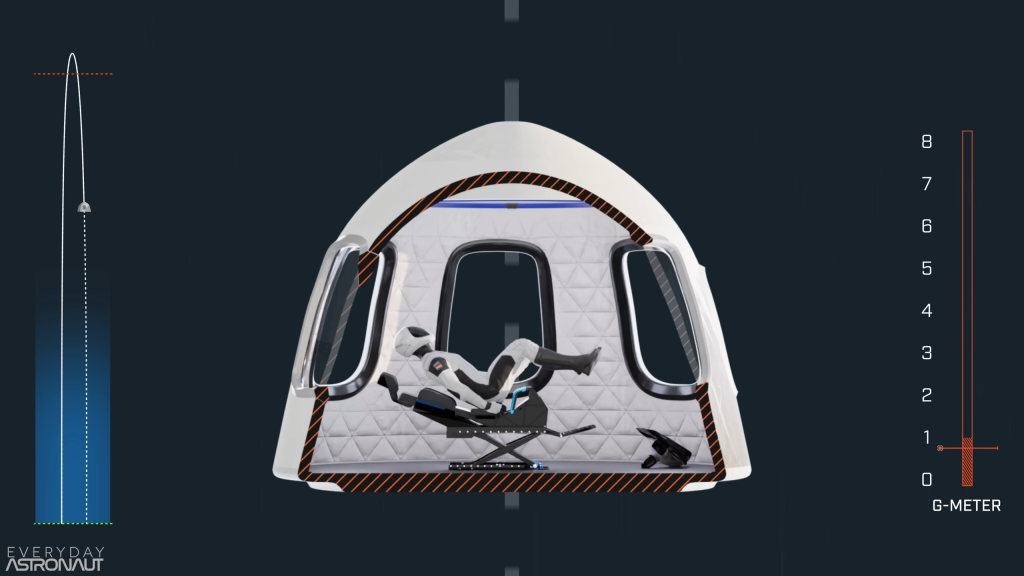
In this case, passengers are feeling the deceleration. The lack of feeling gravity is not because they are in space, but because they and everything around them is experiencing the exact same acceleration. With no air or anything to slow the spacecraft down at different rates compared to the passengers inside, they are for all intents and purposes floating around inside the capsule.
Zero G
The reason why a person can feel gravity on Earth is because they are not accelerating due to the ground stopping them, experiencing 1 G. There’s a decent chance that the person who is reading this has experienced the feeling of zero G before. If you have ever jumped on a trampoline, or have been on a slingshot ride, or a roller coaster, etc.. That brief moment when it feels like your stomach is in your chest is because everything inside you is experiencing the same accelerations. For a brief moment, you are more or less weightless.
This really is all a zero-G flight is. It’s a parabolic flight where the plane is steeply climbing to a certain altitude at which it is following a ballistic trajectory. Passengers are first coasting up and then falling until the plane has come out of its dive, giving the passengers about 30 seconds of weightlessness per cycle.

This is why it is incorrect when people say there is no gravity in space. However, Earth’s gravitational influence does indeed decrease the further away you are from it, but its is not the decrease in Earth’s gravitational influence that makes one feel weightless.
Gravity follows the inverse square law. This means if a person would be twice as far away from a planetary body, its gravity wouldn’t be half as strong, it would be one quarter as strong. People can actually be in space at 100 km, but still be pulled by nearly the same amount of Earth’s gravity as those on the ground. At 100 km in altitude, Earth’s gravity is still pulling a person down at 9.5 m/s2 of acceleration vs the 9.8 m/s2 on the surface. With the Earth’s radius being 6,378 km, another 100 km in altitude doesn’t affect gravity that much.
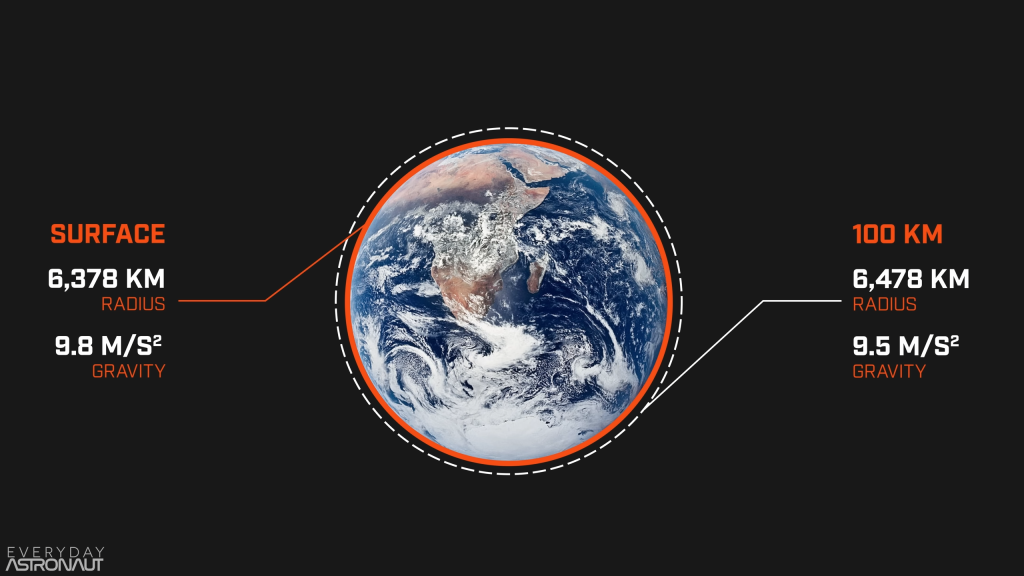

Often times NASA or other entities use the term micro-gravity, which might lead to confusion. Micro-gravity is used to describe the sensation of no gravity, but not confuse people into believing there is no gravity. Zero G, with “G” representing standard Earth gravity, on the other hand is a bit more practical as a G-meter here on Earth would read one G, but when in space it would read zero G, indicating weightlessness. It is not the lack of gravity that makes people experience weightlessness, but the fact that they and the vehicle they are inside are all experiencing the same inertial reference frame.
Similar to gravity decreasing with distance, Earth’s atmosphere is also a gradient. The higher you go, the thinner the air becomes until at some point the atmosphere is so thin that it is virtually non-existent. Just like with gravity, it is not like right at 100 km the Earth’s atmosphere suddenly stops existing. Because space is just the near absence of matter, or the absence of an atmosphere. But where does space start? How little of an atmosphere does there need to be before it is considered “no atmosphere”, since there will certainly be a rogue molecule or two even in the deepest depths of space.
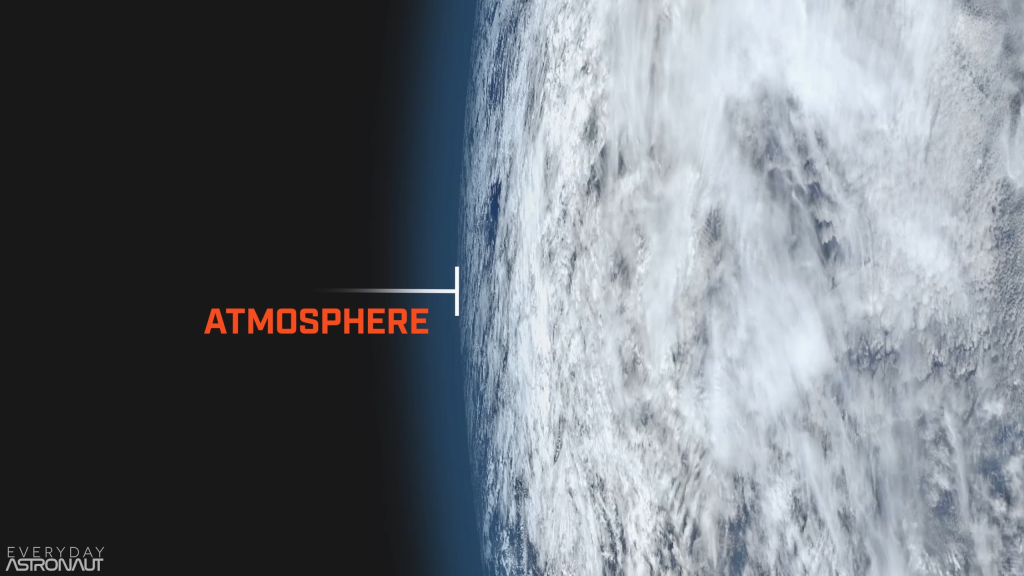
Space And The Karman Line
Earth’s gravity pulls all of the molecules in the atmosphere towards its center of mass, and those molecules in essence are stacked on top of each other, which ends up making the atmosphere thicker and thicker the lower you are. By 100 km in altitude, the atmosphere is virtually non-existent. There will always be a few molecules here and there, but to be pedantic, at 100 km there is roughly 0.000001% the amount of air molecules, as there are at sea level.
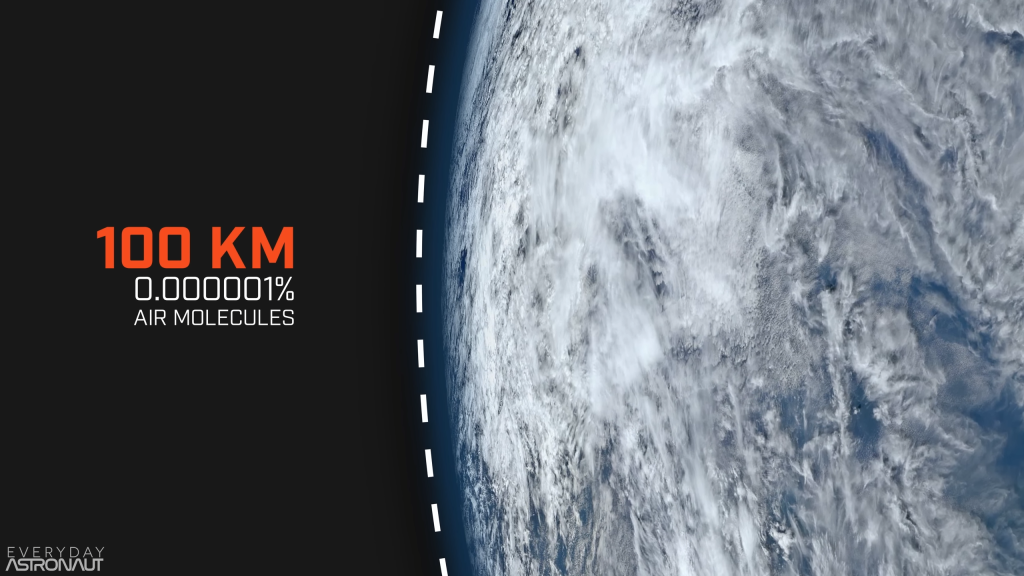
This imaginary line at 100 km is known as the Karman Line, which follows some technical considerations. Considering aircraft and where they can fly, an aircraft needs to overcome gravity via its aerodynamic lift. The thinner the atmosphere, the faster the vehicle has to travel to generate enough lift to overcome gravity.
At extremely high speeds, centrifugal force becomes a contributing factor in maintaining altitude, which is known as Kepler force. These two forces converge at a certain point in altitude where the aerodynamic lift is equal to the Kepler force. An aircraft flying at an altitude greater than that point means that the velocity needed to maintain lift is so high that the Kepler force dominates over the lifting force. At this point, the aircraft is orbiting Earth rather than flying in it’s atmosphere.

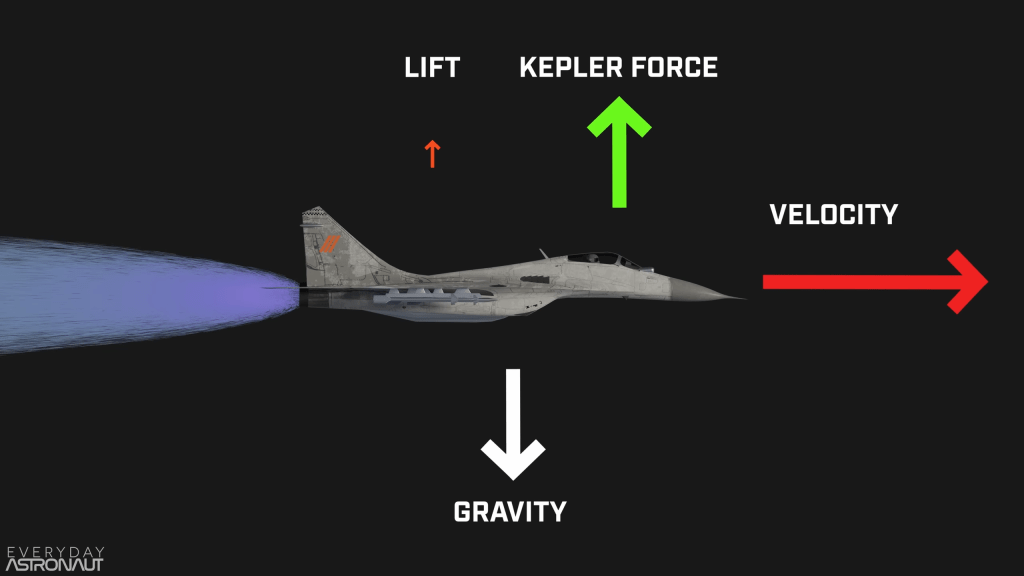
Another consideration is the highest altitude where planes can travel fast enough to generate enough lift to stay aloft, but not so fast that it would overheat the vehicle due to friction. The original calculation of this point was done using the most state of the art aircraft at the time, the Bell X-2, which was made of stainless steel and a copper-nickel alloy to withstand high temperatures.
That chart showed that at an altitude above 83.82 km, the X-2 would have to fly so fast to maintain lift that the heat would be high enough to cause it to lose structural integrity. Assuming some future advances in aerodynamics and material science, the Karman line was raised to 100 km.
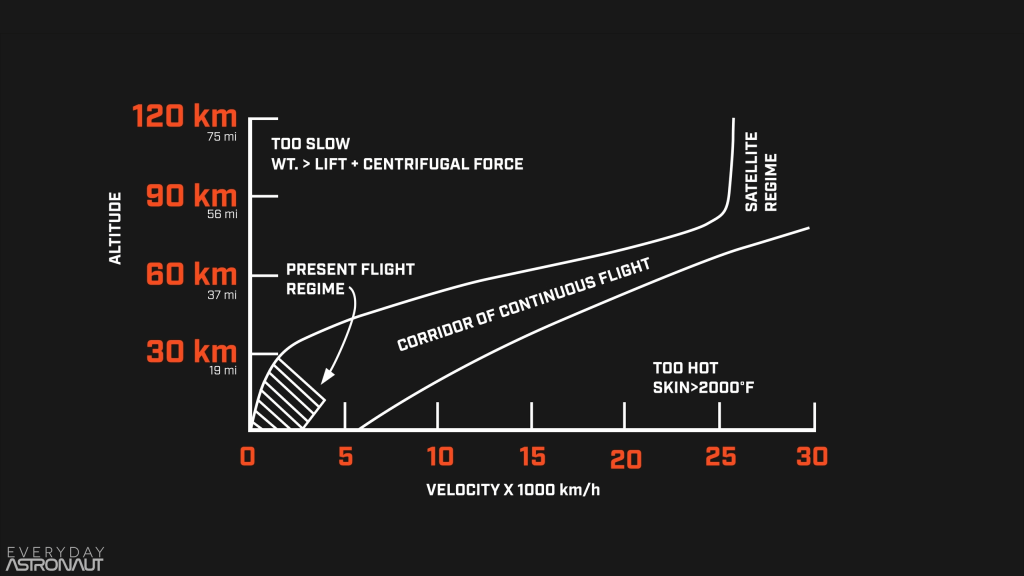
Of course, both lift vs Kepler force and the maximum temperature vs velocity could vary from vehicle to vehicle, but roughly 100 km has become the agreed upon altitude that, regardless of your vehicle’s design, in order to stay above 100 km, you are orbiting rather than flying.
Orbit VS Sub-Orbit
Orbit
In order to understand the differences between orbit and sub-orbit, it is helpful to learn something rather counterintuitive about orbital flight first, starting with a spacecraft already in orbit. This spacecraft is traveling around Earth at around 28,000 km/h, orbiting the planet about every 90 minutes at an altitude of 400 km. If the velocity of this spacecraft changes, the orbit’s altitude will also change, but not at the place the spacecraft accelerates or decelerates, but rather at the opposite side of the planet it is orbiting.
If the spacecraft speeds up in the direction it is traveling, the altitude on the opposite side of its orbit will increase. If the spacecraft decelerates in the direction it is traveling, the opposite would happen. The altitude of its orbit will decrease.
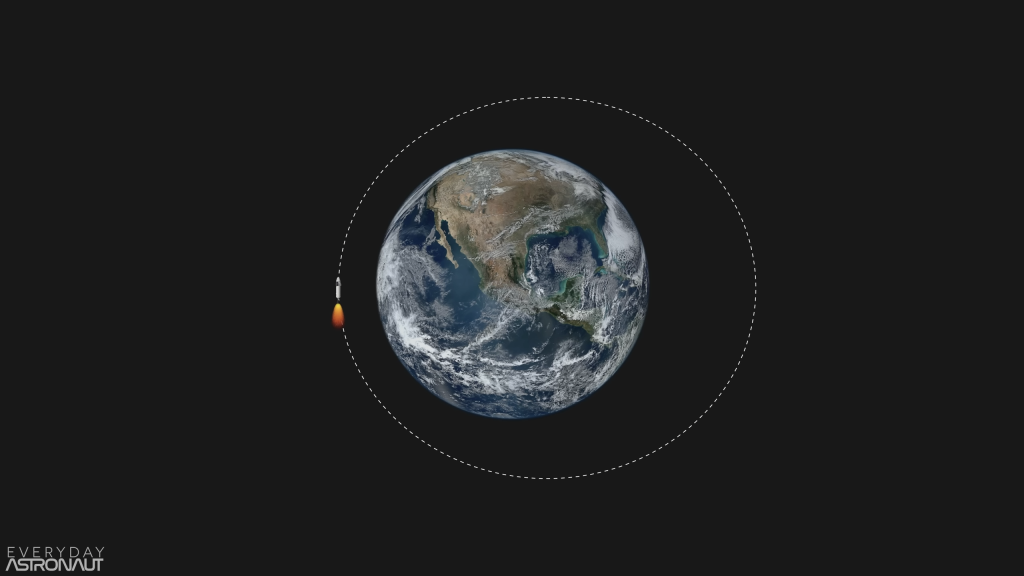

Assuming the orbit is anything but circular, it is called elliptical since the orbit is an ellipse/oval. Once the spacecraft reaches the highest point in its orbit, apogee, it will travel at its slowest speed. From there on it will start to speed up, falling back down towards Earth. At the lowest and closest point of its orbit, perigee, it will travel at the highest speed.
If the spacecraft is in a circular orbit and it speeds up in the direction of travel, it will raise its apogee and will result in an elliptical orbit. It is now at the perigee of its new elliptical orbit with apogee being on the opposite side of the planet. After the spacecraft coasted up to apogee, it can transform this elliptical orbit back into a circular orbit by accelerating in the direction of travel again, raising its perigee until it matches its apogee. The resulting orbit will again be a circular orbit at the higher altitude.
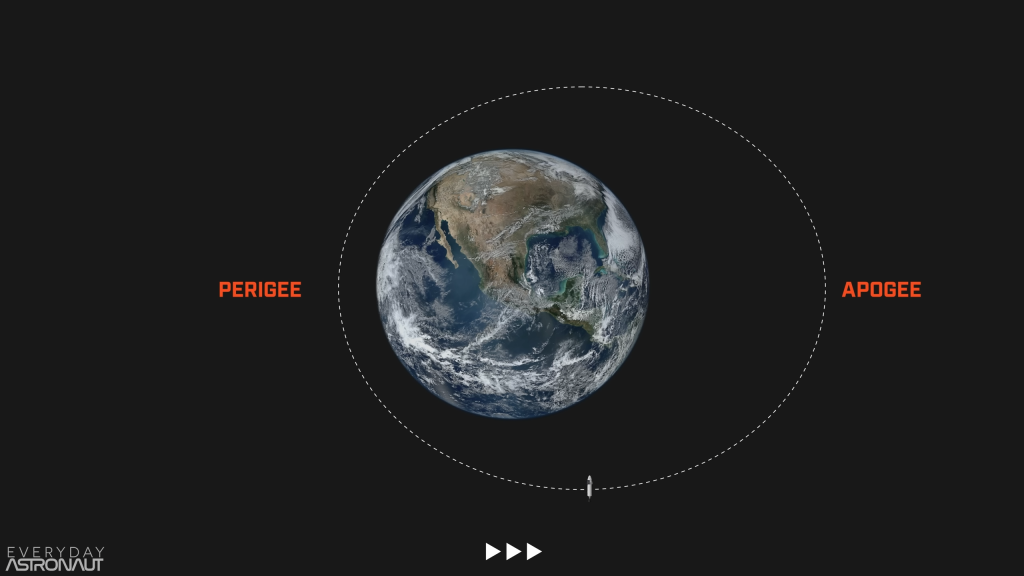
To get back down into a lower circular orbit, the spacecraft has to do the exact opposite. It has to decelerate, coast down to perigee where it will have to decelerate again lowering its apogee until it matches its perigee. To players of the video game Kerbal Space Program this concept will most likely feel very familiar.
Apoapsis and periapsis are generic terms for the highest and the lowest point in an orbit, while apogee and perigee are terms specific to orbits around Earth. Apolune and perilune are further terms that are used for orbits around the Moon, and aphelion and perihelion are the terms when orbiting the Sun.

Sub-Orbit
Assuming a person would throw a ball out the hatch of Blue Origin’s New Shepard rocket right at apogee at around 15 m/s, it would fly sideways relative to that person and would, in the grand scheme of things, end up falling back down, landing pretty close to where New Shepard took off from. This result would be similar to the classic demonstration where someone flicks a ball off a counter and drops another ball off a counter at the same time. Both balls will hit the ground together with one being a bit further away from the counter than the other.
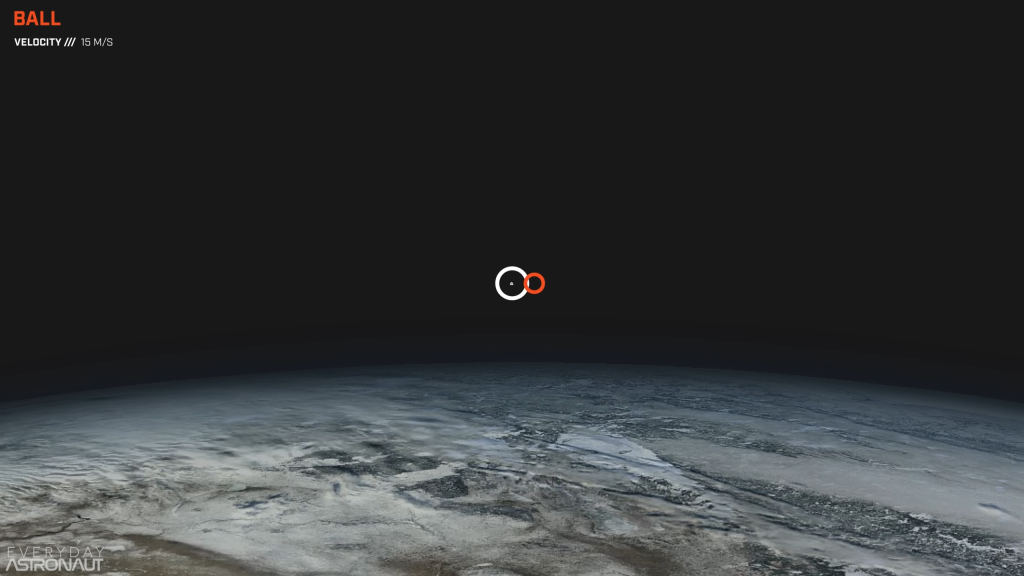

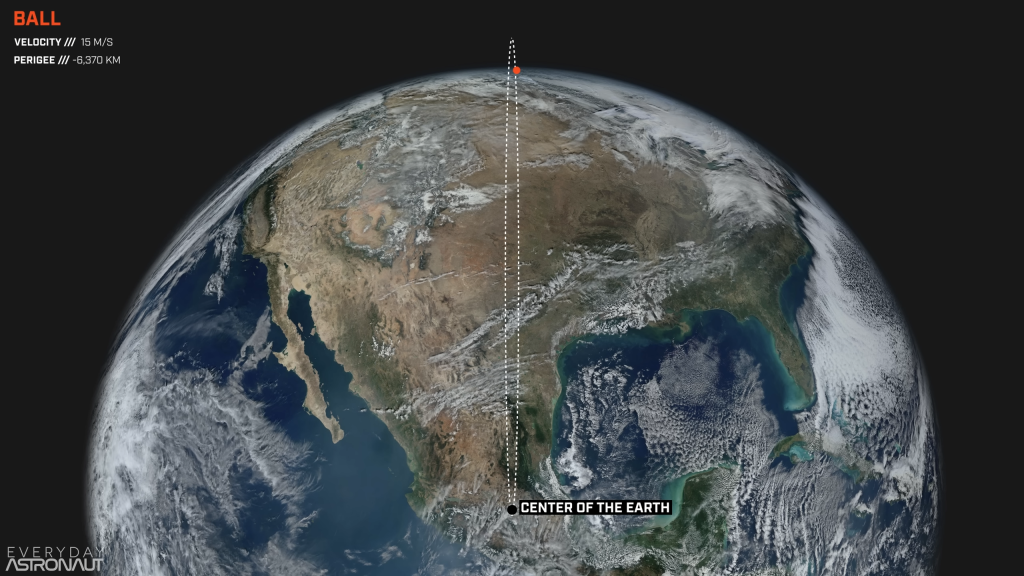
The ball’s trajectory though basically makes an orbit around the center of the Earth, it just runs into the surface of the Earth with its perigee barely being beyond Earth’s center point, since the ball was not traveling very fast at its apogee. As mentioned earlier, the faster an object is traveling at apogee, the higher up is its perigee. With the ball going VERY slowly at apogee, its perigee is DEEP within the Earth, only a fraction above the center of the Earth. To get into an orbit the ball would have to raise its perigee by a lot and the best way to do this is by increasing its speed.
A bullet shot horizontally from a pistol at New Shepard’s apogee at around 350 m/s will go much further than the aforementioned ball at 15 m/s, but it will still collide with Earth. Again, the trajectory of the bullet basically follows a path as if it is orbiting the center of the Earth. Comparing both trajectories, the ball’s and the bullet’s trajectory, the bullet’s perigee will still be close to the center of the Earth, but higher up than the ball’s one. The bullet’s perigee is higher than the ball’s as it was traveling faster at apogee than the ball.
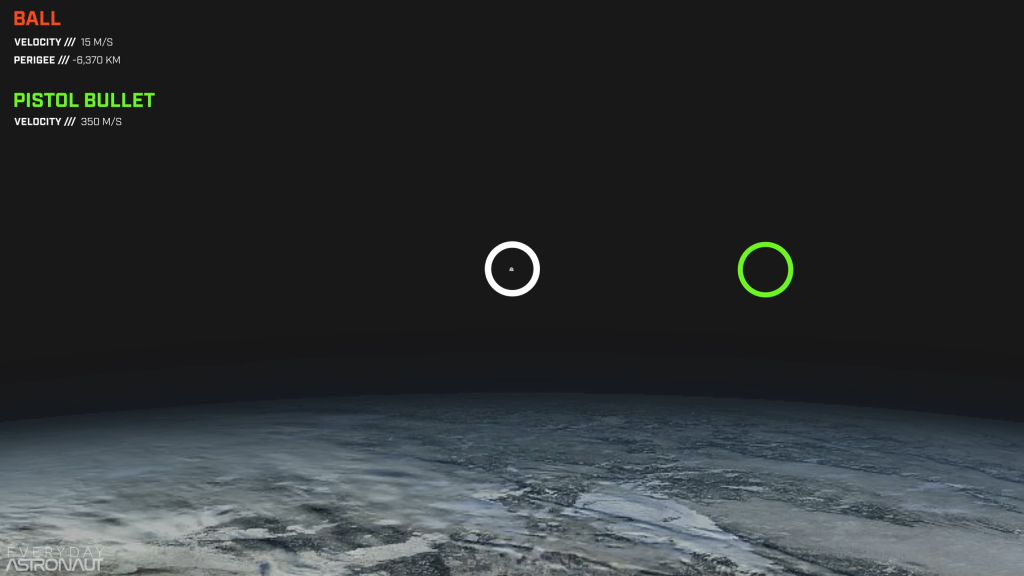
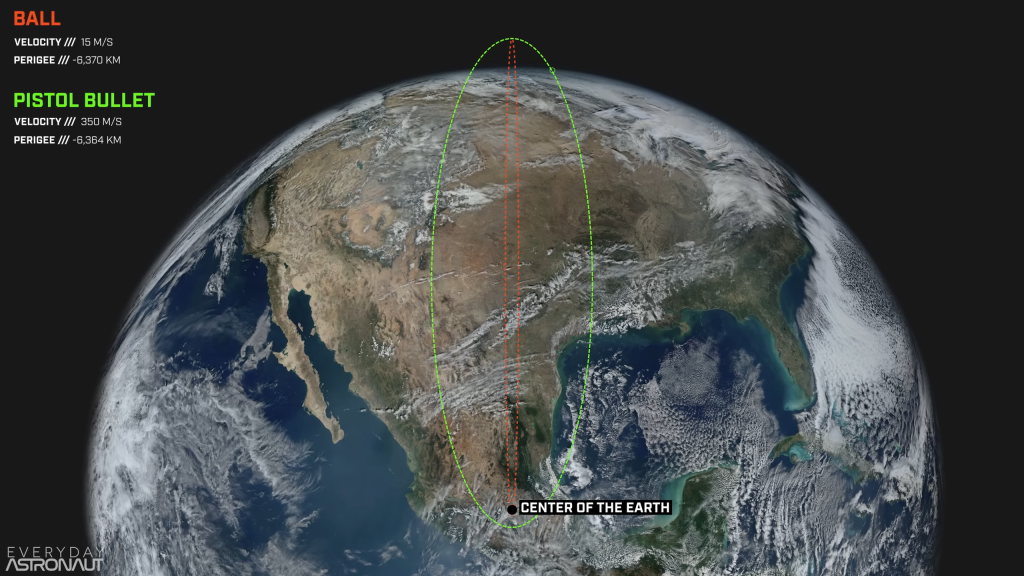
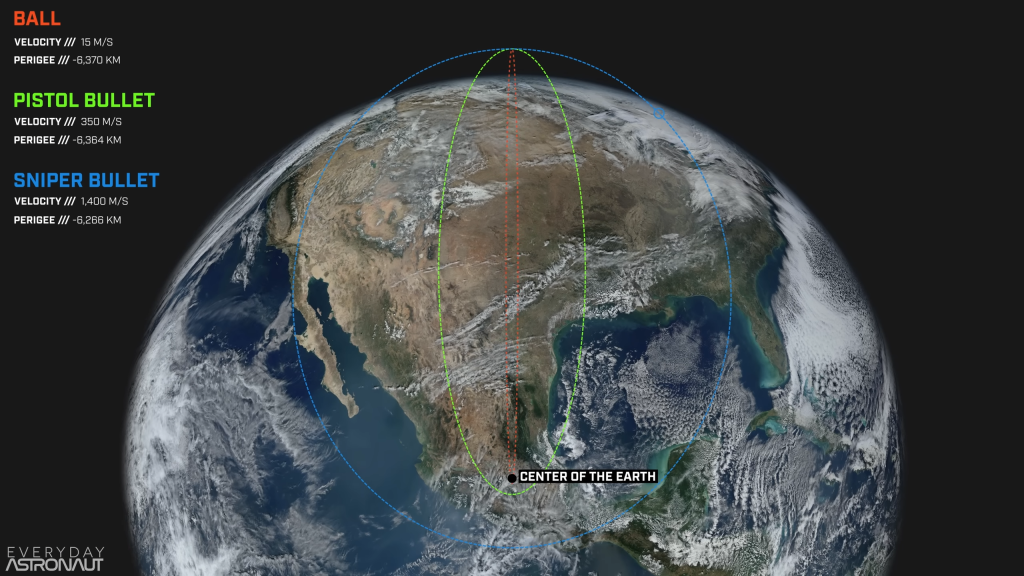
Stepping it up even more, firing a bullet from a sniper rifle at apogee at around 1,400 m/s will result in a similar outcome as that which occurred with the bullet shot from a pistol. This time it will fly even further, but gravity will still pull the bullet down and it too will hit the atmosphere and eventually, the ground. Just like the pistol bullet compared to the ball, the bullet shot from a sniper rifle will have a higher perigee than the pistol bullet.
Getting Into Orbit
In order to stay in space, an object needs to reach a velocity of roughly 7.8 km/s, which is about 28,000 km/h, or about 17,500 mph. At this velocity, the arc of an object’s trajectory would go beyond the horizon and it will miss the atmosphere and Earth entirely.
It would be extremely difficult to get things into orbit by shooting them out of a really large gun to achieve orbital velocities, especially something as fragile and soft as humans. This is why an orbital rocket will continually accelerate for about eight minutes to reach orbital velocity. Since it gets above pretty much all the atmosphere that would slow it down, it will now continue orbiting Earth until it de-orbits.

If the engine of a rocket is shut down, the rocket will follow its ballistic trajectory coasting up to apogee before it will start falling back down. The faster the rocket is traveling, the further that ballistic arc gets in front of the rocket because of the rocket’s inertia. The trick is to start to aim that trajectory beyond the horizon. After an initial ascent, the rocket starts pitching over to gain more and more horizontal velocity. This way the rocket’s trajectory will continue out over the atmosphere.
After the rocket pitches over, it will continue to speed up, raising its perigee until it will be above Earth’s surface and above Earth’s atmosphere. Assuming the rocket has enough inertia to get above the atmosphere, the most important thing to do is to accelerate horizontally to raise its perigee.
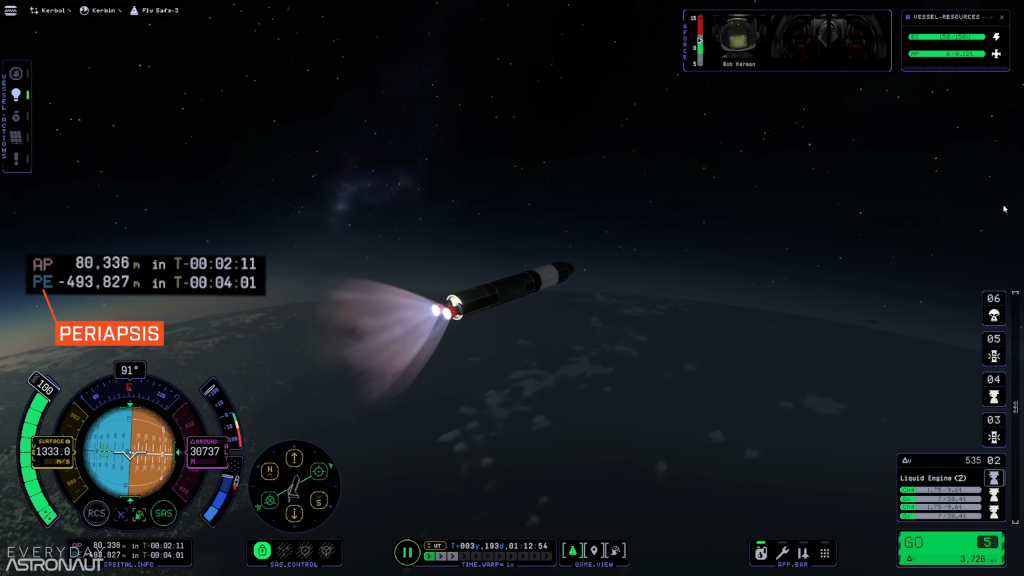
Sub-Orbital Rockets VS Orbital Rockets
Compared to the 3,000 km/h a suborbital ride achieves, the roughly 28,000 km/h needed for orbital spaceflight requires a far more complicated and more powerful vehicle. This difference gets pretty obvious when comparing the scale and configuration of Blue Origin’s New Shepard with SpaceX’s Falcon 9.
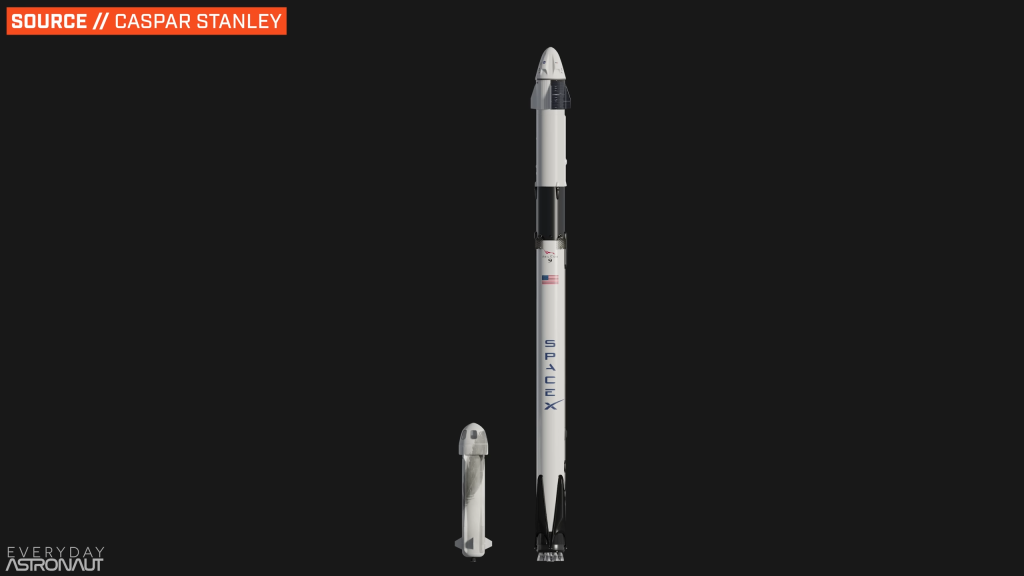
This doesn’t even go into all the other considerations like long term life support, reentry velocities/heat and logistics, orbital communications, and many more. Summarizing, orbital class rockets require way more considerations and require a far more complex vehicle than suborbital rockets.
Summary
Getting to space and going into orbit are two very different things. Vehicles can’t orbit without the airless environment of space, but they can be in space without being in orbit, albeit for a brief moment in time. Getting above the atmosphere is vital so the atmosphere doesn’t slow the object down. If an object’s orbit bites into the atmosphere too much, it will slow it down, which lowers the orbit, which means there’s more atmosphere to slow it down and lower the orbit until it de-orbits.
This is even a consideration on a larger time scale for everything in low Earth orbit. For example, the atmosphere at around 300 km is nearly non-existent, resulting in de-orbit times of months to years due to atmospheric drag. This is really the only reason rockets even go up in the first place. If Earth had no atmosphere, rockets could simply launch from a high point, fly ever so slightly up to avoid terrain and then just accelerate up to orbital velocity straight sideways, resulting in an orbit at a very low altitude. In fact, this is true on the moon.
The other thing to remember is that just because an object is in space, it doesn’t mean that there is no gravity. The amount of gravity an object experiences in low Earth orbit is nearly the same as the amount of gravity down on Earth’s surface. The reason a person feels weightlessness is because they and the spacecraft they are inside are all basically falling at the same rate. The reason they don’t hit the ground is because they have so much velocity forward, they are constantly missing the ground.
At the end of the day, it can be easy to say suborbital as if it is some kind of snide comment, or be cynical that it is just some meaningless joy ride for billionaires. Of course, there is some truth to some of that, but that doesn’t mean it is pointless.
At 90 years old, William Shatner viewed Earth from space on Blue Origin’s New Shepard and he was utterly speechless and emotional when he landed. In fact, he felt immense grief at the fragility of our planet and had a strong reaction often known as the “overview effect.” The perspective of seeing our Earth from space is often eye opening and enlightening for people. It helps them understand the borderless nature of our species, how we are all neighbors just sharing this fragile little blue ball.
That is not all suborbital rides are good for. They actually do serve a scientifically important purpose. The ability to have four full minutes of weightlessness is often plenty of time to perform vital and significant experiments. In fact, NASA has a 132 m deep vacuum chamber that allows experiments the opportunity to experience 5.18 s of free fall. If it is worth having a 132 m deep vacuum tunnel for 5.18 s for research scientists, imagine what four minutes of clean zero G would be worth!






Great balance of detailed information at a pace that can be readily digested!
A suggested edit:
Zero G section, 3rd paragraph, second sentence reads:
“However, Earth’s gravitational influence does indeed decrease the further away you are from it, but its is not the decrease in Earth’s gravitational influence that makes one feel weightless.”
Seems you meant to say, “but IT IS not the…”, instead of ,”but ITS IS not the…,”.
Thank you so much for the awesome content!
Great article, It was very fast paced and very easy to understand, with all the required information.